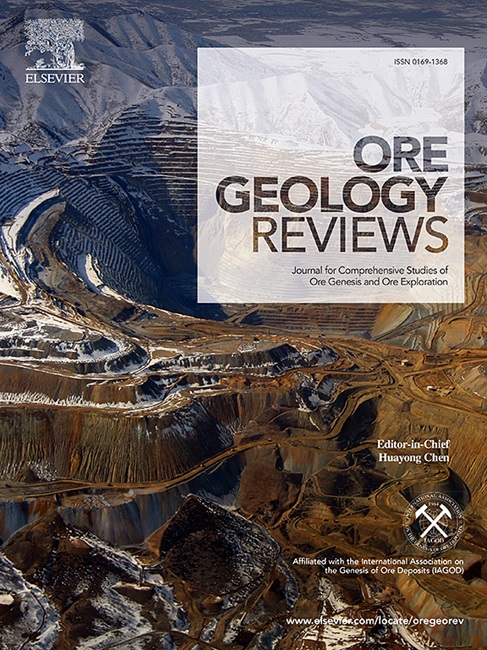Destruction of the North China Craton account for the Shijia gold deposit in the Jiaodong Peninsula, eastern China
IF 3.2
2区 地球科学
Q1 GEOLOGY
引用次数: 0
Abstract
The Jiaodong Peninsula hosts the largest gold reserves in China, with proven gold reserves exceeding 5000 tons. Although the continuous discovery of new gold deposits in this region, the geodynamic background and the source of ore-forming materials of mineralization remain subjects of debate. Resolving this issue will be of great significance for further mineral exploration. This study focuses on the Shijia quartz vein-type gold deposit, which is hosted in Guojialing-stage granitoids within the Jiaodong Peninsula. We employ a variety of analytical techniques, including zircon LA-ICP-MS U–Pb isotopic dating, pyrite Rb–Sr isochron dating, geochemical analyses of the Shijia granodiorite, in-situ sulfur isotope and trace element analyses of pyrites, in order to obtain the accurate timing of gold mineralization and to uncover the origin of ore-forming materials. Our results show that the Shijia granodiorite was emplaced at 122.9 ± 0.2 Ma. The Rb–Sr isochron analysis of gold-bearing pyrite determines its mineralization age to be 121.3 ± 2.4 Ma, which agrees well with both the crystallization age of the Shijia intrusion and the time of destruction of the North China Craton, implying their genetic connections. Whole-rock geochemical data indicate that the Shijia granodiorite originated from a mixing magma source, primarily composed of ancient lower continental crust with approximately 20 % contribution from asthenospheric mantle, which is possibly formed in the background of the North China Craton destruction. The sulfur isotope values (6.22 to 7.59 ‰) of the gold-bearing pyrites point to a primary contribution from deep mantle sources for the ore-forming fluids. Based on the aforementioned features and the strong spatial and temporal correlation between mafic dykes and gold mineralization, we suggest that the Shijia gold deposit is a product of cratonic destruction. The destruction of the North China Craton is likely responsible for the ascent of asthenospheric material, which in turn triggered the partial melting of the metasomatized subcontinental lithospheric mantle and the ancient lower crust. This process generated large-scale contemporary granitic rocks, mafic dykes, and associated gold mineralization.

华北克拉通的破坏是胶东半岛石家金矿床形成的主要原因
胶东半岛是中国黄金储量最大的地区,已探明黄金储量超过5000吨。虽然该区金矿新发现不断,但对成矿的地球动力学背景和成矿物质来源仍有争议。这一问题的解决对今后的矿产勘查具有重要意义。本文研究了胶东半岛内产于郭家岭期花岗岩体中的石家石英脉型金矿床。采用锆石LA-ICP-MS U-Pb同位素测年、黄铁矿Rb-Sr等时线测年、石家花岗闪长岩地球化学分析、黄铁矿原位硫同位素及微量元素分析等分析技术,准确确定金矿成矿时间,揭示成矿物质来源。结果表明,石家花岗闪长岩的侵位在122.9±0.2 Ma。含金黄铁矿的Rb-Sr等时线分析确定其成矿年龄为121.3±2.4 Ma,与石家侵入期结晶年龄和华北克拉通破坏时间吻合较好,暗示了两者的成因联系。石家花岗闪长岩的全岩地球化学资料表明,石家花岗闪长岩为混合岩浆源,岩浆源主要由古代下陆壳组成,软流圈地幔贡献约20%,可能形成于华北克拉通破坏的背景下。含金黄铁矿硫同位素值(6.22 ~ 7.59‰)表明成矿流体主要来自深部地幔源。综合上述特征及基性岩脉与金矿化的强烈时空相关性,认为石家金矿床是克拉通破坏的产物。华北克拉通的破坏可能是软流圈物质上升的原因,软流圈物质上升又引发了变质的次大陆岩石圈地幔和古下地壳的部分熔融。这一过程产生了大规模的当代花岗质岩石、基性岩脉和伴生的金矿化。
本文章由计算机程序翻译,如有差异,请以英文原文为准。
求助全文
约1分钟内获得全文
求助全文
来源期刊

Ore Geology Reviews
地学-地质学
CiteScore
6.50
自引率
27.30%
发文量
546
审稿时长
22.9 weeks
期刊介绍:
Ore Geology Reviews aims to familiarize all earth scientists with recent advances in a number of interconnected disciplines related to the study of, and search for, ore deposits. The reviews range from brief to longer contributions, but the journal preferentially publishes manuscripts that fill the niche between the commonly shorter journal articles and the comprehensive book coverages, and thus has a special appeal to many authors and readers.
 求助内容:
求助内容: 应助结果提醒方式:
应助结果提醒方式:


